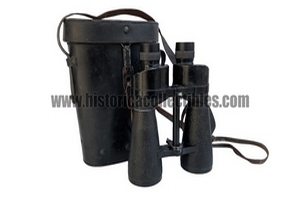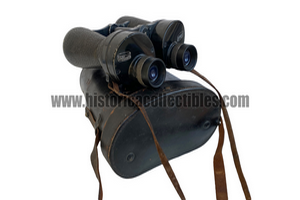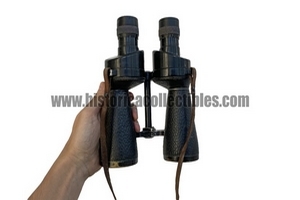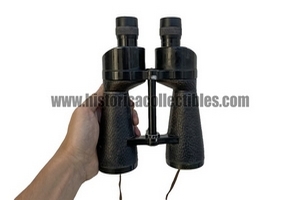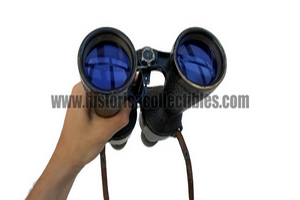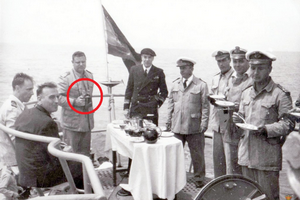Binoculars 7x50H Prismensystem, Luminar, LTIEMA, Armada Española, around 1948
Binoculars 7x50H Prismensystem model Luminar A, made by LTIEMA - Laboratorio y Taller de Investigaciones del Estato Mayor de la Armada (Research Laboratory of the Major State of the Spanish Navy), in Chamartín, Madrid, around 1948, with 0XX serial number.
Its extremely compact conformation betrays a weight of about 1.4 kg, which makes it a truly solid binocular with a structure perfectly suitable for naval use thanks also to the blue anti-reflective treatment present both on the ocular lenses and on the objective lenses.
The following models of binoculars were produced at LTIEMA:
Minar 4x15
Medimar 6x30
Medigón 8x30
Luminar 7x50
Luremar 7x50
As regards the LUMINAR 7x50 model, after various attempts, external protection was obtained capable of withstanding the "crash tests", consisting of throwing the binoculars, while the Submarine was on the surface, through the hatch inside the ship without suffer any damage or misalignment of its optical axis.
LTIEMA copied most of the devices it put into production, but always tried to improve the sample. Copying the designs and manufacturing technology was very difficult, but it allowed him to learn enough to design similar or better devices later.
To copy an optical device, extremely precise equipment and qualified personnel were needed to handle it. Due to the scarcity of resources at the time, the devices to be copied were not destroyed; they had to be dismantled and reassembled without suffering damage. The procedure to follow was as follows:
1st - The Assembly Section was responsible for separating the optics from the mechanics (dismantling the device as much as possible).
2nd - The mechanical parts were studied in the Metallographic and Metrological Laboratories and the data obtained, together with the pieces, had to be sent to the Mechanical Projects Office.
3º - The optical pieces (lenses and prisms) sent to the Optics Laboratory, where focal lengths, radii, thicknesses, diameters and refractive indices were measured and subsequently sent to the Optical Calculation Office, directed by D. Pedro Jiménez-Landi.
All this data was used only to know the correction status of the device to be copied. In many cases the necessary optical glasses were missing and the Optics Laboratory had to recalculate a new system that was corrected for aberrations as an instrument to be copied. The same problem existed for the manufacturing of mechanical parts.
José María Otero Navascués also founded the Empresa Nacional de Óptica, S.A. (ENOSA) whose mission would be to produce the LTIEMA prototypes. At the same time he sought collaboration with the ZEISS company from Oberkochen with the aim of creating a synergy between ZEISS, LTIEMA and ENOSA to extend their products outside of Spain. Having obtained a contract between ENOSA and ZEISS Oberkochen, a team of German experts composed of five engineers and a master carver moved from Oberkochen to Madrid to organize the work in the different sections and equip them with the necessary machines.
The National Institute of Industry (INI) covered the construction and start-up costs of the factory.
The German engineers and the workshop master settled in the LTIEMA, until the ENOSA works were completed.
Among them were Mr. Müller, an engineer specializing in rangefinders, and Mr. Stolenberg, an optics laboratory teacher.
Otero Navascués' idea was more ambitious: to transform ENOSA into a branch of ZEISS in Oberkochen, while the Technical and Commercial Management would be shared between the two entities. ENOSA was to produce all devices ordered by Zeiss under the ENOSA brand, adding that they adopted the Zeiss system. ENOSA would have had autonomy to design, calculate, and produce its own devices. Zeiss reserved the manufacture of glasses.
But relations between ENOSA and ZEISS broke down and the Germans left, so ENOSA began producing binoculars and sextants with LTIEMA projects.
ENOSA built several models of binoculars, a "Cadet" model microscope, an aneroid barometer and various teaching materials such as binocular lenses, microscopes and projectors. ENOSA paid royalties to LTIEMA for the production of its prototypes.
ENOSA has produced, under license from LTIEMA, the following binoculars:
Minar 4x15, with Sprenger-Leman prisms and central focus.
Medimar 6x30
Medigón 8x30
Alhambra 8x30, with Porro prisms, single shell casing and central focus
Luremar 7x50, with Porro prisms, single dome casing and individual focusing.
EXCERPT AND TRANSLATED FROM: The history of the optical development centers that existed in Spain in the 1940s and 1950s (Daza de Valdés Institute of Optics, LTIEMA, ENOSA and TPYCEA) is described succinctly in relation to the production of Spanish binoculars by quality, mainly for Army and Police use.
Source: https://hispanismo.org/ciencia/20303-tecnologia-optica-espanola.html

